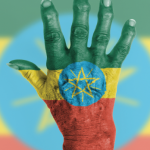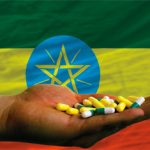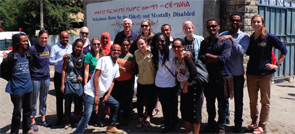
Physical therapists, Doctor of Physical Therapy students and a Doctor of Pharmacy student (from Ethiopia or Regis University in Denver) collaborate on the Global Physical Therapy Day of Service, Oct. 17, 2015, in Addis Ababa, Ethiopia.
Image Credit: Credit: Dr. Kim Feldhaus
Ethiopia has a rich, variable and distinguished history and landscape. Located in the Horn of Africa, it shares borders with Eritrea, Djibouti, Somalia, Kenya, Sudan and South Sudan. Ethiopia has claim to the oldest humanoid fossils, named “Lucy,” which were discovered in 1974 and are estimated to be 3.2 million years of age.1 The country’s geographical landscape varies greatly and includes Ras Dashen, the highest peak measuring 14,927 feet, and Kobar Sink, a depression measuring 377 feet below sea level.1 The Blue Nile is believed to originate from a Spring near Lake Tana in northwest Ethiopia and travels west and north through Sudan, where it ultimately joins with the White Nile to form the Nile River.
The health resources available for individuals in Ethiopia are evolving. Currently, the population of Ethiopia is more than 96 million, and the average life expectancy is 54 and 57 years for men and women, respectively.2,3 The physician to population ratio has been estimated at 1:36,158, which compares to the United States ratio of approximately 1:417.4,5
Physical Therapy in Ethiopia
Physical therapy (PT) is an emerging profession in Ethiopia and is contributing to the rehabilitation needs of the people of Ethiopia. The first formal program in physical therapy in Ethiopia started at the University of Gondar in 2006. More than 300 individuals have graduated with a bachelor’s or master’s degree from the University of Gondar. In addition, there is a Doctor of Physical Therapy program educating physical therapists in advanced academic and clinical skills at Addis Ababa University.
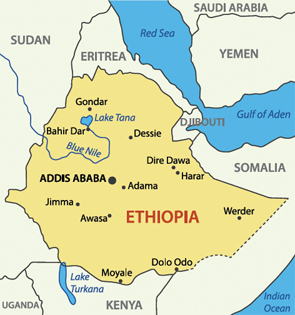 As an associate professor in the School of Physical Therapy at Regis University in Denver, I have had the opportunity to work with the physical therapists in Ethiopia, both as colleagues in the education of students, as well as an instructor, providing courses within the Addis Ababa University Doctor of Physical Therapy program.
As an associate professor in the School of Physical Therapy at Regis University in Denver, I have had the opportunity to work with the physical therapists in Ethiopia, both as colleagues in the education of students, as well as an instructor, providing courses within the Addis Ababa University Doctor of Physical Therapy program.
I have had the privilege of traveling to Ethiopia four times over the past six years. Regis University’s Rueckert-Hartman College for Health Professions offers immersion programs for students in the health fields to collaborate with healthcare providers within and outside the United States. I served as a faculty mentor for three cohorts of Regis University’s Doctor of Physical Therapy students during three of my visits to Ethiopia and as an instructor at Addis Ababa University’s Doctor of Physical Therapy program for the additional visit. The time spent on these immersion experiences was heart warming, enlightening and engaging as we collaborated with medical professionals in the developing healthcare system.
Establishing professional relationships with the physical therapists in Ethiopia is at the core of our collaboration. Their generosity in mentoring/supervising our students in the clinic, strength in modeling care in the unique environments, and excellence in teaching while treating patients facilitates the engagement. Language barriers are minimized, with the therapists’ knowledge of English. Discussions related to the impact of culture and values on approach to patient care promote growth in establishing relationships and respecting difference. We have collaborated in rural and urban hospitals, specialty clinics, outpatient facilities, community homes and schools. Sharing knowledge related to culture, patient care and the profession of physical therapy fosters an understanding of resources, professional goals, life experiences and future directions.
Contrasting Perspectives
Diagnoses encountered by the American physical therapists and students while working with the physical therapists in Ethiopia range from the “familiar” to the “rarely seen.” For example, musculoskeletal dysfunction, post-trauma recovery, cardiovascular dysfunction and wound care would be diagnoses treated by therapists in both countries. Working with individuals with spinal tuberculosis, polio or Hansen’s disease would not be common in the U.S.
Specific to rheumatology, an informal survey of physical therapists in Addis Ababa indicates it’s not uncommon to treat individuals with osteoarthritis, rheumatoid arthritis, gout and ankylosing spondylitis. Treatment interventions for individuals with arthritis include, as appropriate, joint mobilization, range of motion, exercise, splinting, hydrotherapy and other modalities. Mechanisms to identify and address various types of rheumatological disorders are evolving in Ethiopia, which may increase the type and number of patients treated by their physical therapists.
Current literature, such as “Cardiovascular risk factors and carotid atherosclerosis in patient with systemic lupus erythematosus at Kenyatta National Hospital” by Shiruli et al, published in 2014, increases awareness of rheumatology disease processes that can be addressed by physical therapists, including cardiovascular risk factors.6
Prevalence
Tracking the type and prevalence of rheumatological disease in Africa is advancing. Historically, the burden of rheumatology disorders in Africa has been overshadowed by life-threatening disorders, such as tuberculosis, malaria and human immunodeficiency virus (HIV).7 However, literature is emerging that explores the burden of non-communicable diseases in Africa.7-10
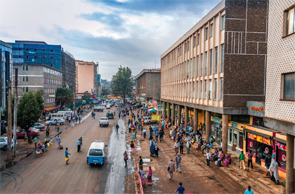
In the streets of Addis Ababa, the capital of Ethiopia.
Associations exist that increase knowledge and communication related to the state of rheumatological disorders in Africa. The African League for Associations of Rheumatology (AFLAR), established in 1989, recently initiated the biannual publication of the peer-reviewed African Journal of Rheumatology (AJR).11,12 The Community Oriented Program for Control of Rheumatic Diseases (COPCORD) is a program that collects data on “pain and disability” from rheumatic disease in developing countries, using a grassroots approach.13 COPCORD may also increase awareness of prevailing diagnoses that can be partially or fully managed by physical therapists.
In addition to the clinical aspect of collaboration in Ethiopia, we have engaged with many other community organizations working with the people of Ethiopia to improve health and the quality of life. They exhibit extraordinary dedication and exemplify characteristics that inspire the faculty and students participating in the immersion. Organizations that focus on women and child health, clinics that provide life-changing opportunities for young people with spinal tuberculosis, community-based compounds that develop self-sustaining life resources and cooperatives that train individuals with disabilities to make glasses to improve the sight of others demonstrate the power of commitment and compassion.
Summary
The experience of working with the physical therapists and other organizations in Ethiopia is life changing. Collaboration in learning, sharing best-practice guidelines based on patient diagnoses and culture, mentoring students in current practice in a developing country, and recognizing common goals of providing best outcomes for our patients forms a professional bond that strengthens the global vision of physical therapy.
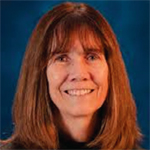 Mary E. Christenson, PT, PhD, is an associate professor at the School of Physical Therapy, Regis University in Denver. She has been a member of the ARHP for about 30 years.
Mary E. Christenson, PT, PhD, is an associate professor at the School of Physical Therapy, Regis University in Denver. She has been a member of the ARHP for about 30 years.
References
- Milkias P. Africa in Focus: Ethiopia. Santa Barbara, CA: ABC-CLIO, LLC; 2011.
- Worldometers—Populaton.
- Centers for Disease Control and Prevention (CDC). Global Health—Ethiopia.
- Federal Democratic Republic of Ethiopia Ministry of Health. Health Sector Development Programme IV, 2010/11-2014/15, Final Draft. October 2010.
- The World Bank—Physicians (per 1,000 people).
- Shiruli BC, Oyoo GO, Ogola EN, et al. Cardiovascular risk factors and carotid atherosclerosis in patients with systemic lupus erythematosus at Kenyatta National Hospital. Afr J Rheumatol. 2014;2(2):64–69.
- Dowman B, Campbell RM, Zgaga L, et ak. Estimating the burden of rheumatoid arthritis in Africa: A systematic analysis. Journal of Global Health. 2012;2(2):1–9.
- McGill PE, Oyoo GO. Rheumatic disorders in Sub-Saharan Africans. East African Medical Journal. 2002;79(4):214–216.
- Misganaw A, Mariam DH, Ali A, Araya T. Epidemiology of major non-communicable diseases in Ethiopia: A systematic review. J Health Popul Nutr. 2014;32(1):1–13.
- Oyoo O, Moots RJ, Ganda B. Editorial—Stepping into the state of rheumatology in East Africa: What do we need? Rheumatology. 2012;51:1345–1346.
- AFLAR: African League of Associations for Rheumatology—About AFLAR.
- AFLAR: African League of Associations for Rheumatology. African Journal Rheumatology.
- Community Oriented Program for Control of Rheumatic Diseases (COPCORD).
